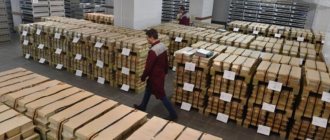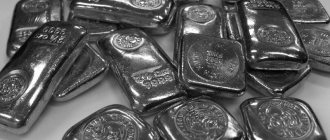Perhaps every person will be interested in the answer to the question of where Russia’s gold reserves are stored. This is due to the fact that the country's gold and foreign exchange reserves are the largest in the world. Initially, the formation of the reserve was due to the need to physically confirm the solvency of the country when building international economic relations. The high cost of gold helps keep the economies of countries at a stable level. It is the reserve that supports the banking sector during periods of international crises by providing bank guarantees to depositors. The gold reserves of countries have always been classified as the main strategic reserves in case of any unforeseen situations and circumstances.
Gold as a guarantor of economic stability
Gold can safely be called a kind of guarantee that the country’s economy will not collapse. Take Russia, for example. It is the reserves that allow it not only to stay afloat, but also to strive for development. Without gold reserves, the country's economy would not be able to survive the sharp decline in oil prices and harsh sanctions from the West. The value of a currency forms a reserve; it acts as the basis of the economy. The world status of a state directly depends on how much it has managed to accumulate precious metal. Any issued banknote, even in a small amount, must be backed by gold, which will eliminate the high risks of devaluation in the future. Today the situation has changed a little, and national currencies are largely backed by the American dollar, the circulation of which is backed by gold by only 1%.
The role of gold remains unchanged
Gold is not just one of the most liquid precious metals in the world. All modern economic policies are based on metal reserves, guided by the need to purchase foreign currency. Precious capital acts as a security deposit both when obtaining loans and when transferring expensive goods to foreign countries. Over the many centuries of existence of the modern economic structure, the role of gold has not changed. The metal, as before, protects countries from collapse and makes it possible to provide assistance to partner countries in the event of a sharp decline in the economy. Everyone knows that Russia has the largest gold and foreign exchange fund, but let’s try to look into the question of where Russia’s gold reserves are stored below.
Amur region
The Amur region competes with the Irkutsk region. The extraction of yellow metal is carried out both in mines and in placers. Numerous prospectors flock here. Here's where you can mine gold in Russia:
- “Berezitovoye” deposit (Tyndinsky district, Khaikta river). 2 thousand tons of gold are mined here annually using the open-pit method. Nordgold plans to move to underground work, which has not been carried out in the region since 1994.
- "Pioneer" (Magdagachinsky district) was put into operation in 2008.
Where has the government placed its savings?
It is a well-known fact that the location of the “guarantor” of the Russian state has never been hidden from anyone. Almost any person interested in economics can easily answer the question of where Russia’s gold reserves are stored. According to publicly available information, about 60% of the total reserve is located in the Central Repository of the Central Bank of the Russian Federation, which is located in Moscow on Pravdy Street. The area of the room is 17 square meters. As for the space allocated exclusively for storing supplies, it amounts to one and a half thousand square meters. The storage facility was built in 1940. The construction of an important state facility was supervised by the Administration of the State Bank of the USSR. Considering the question of where Russia's gold reserves are stored, I would like to say that the storage facility in Moscow is not the only location of the reserve. Branches operate in St. Petersburg and Yekaterinburg. The general structure of storage facilities is very extensive and is distributed throughout the country in order to ensure government liquidity. There are at least 600 settlement centers in total, each of which has its own storage facilities.
Gold mining map
In this article I will consider only a few regions of Russia - keep in mind, there are many more, especially in the Far East, Far North and Siberia.
Deposits of the European part of the Russian Federation
The largest amount of gold was deposited in areas where magma often reached the land surface - now there are mountains and hills, like in the Urals and Magadan. Therefore, in Central Russia there is almost no search for gold.
There are some placer deposits in the Kostroma region, on the Chabra and Chashchevaya rivers, but they are unlikely to be of interest to large gold mining companies. However, this is not a hindrance for amateur enthusiasts: if you want to try to wash a couple of grams of precious metal in the river, know that this is possible.
West of the Ural Range there are only three industrial gold mining provinces:
- Dnieper-Donetsk zone;
- Karelo-Kola;
- Caucasian.
The gold mining potential of these zones is the smallest of all those located in Russia.
Deposits of the Urals and Trans-Urals
The Ural gold mining province is fourth in the Russian ranking. It is inferior to the Baikal-Vitim, Altai-Sayan and Verkhoyansk-Kolyma provinces. The development of deposits in the Urals began in the 18th century, and by the end of the 20th century there were already more than 300 mines operating here.
The gold mining industry is most interested in primary deposits, but in the Urals and the West Siberian Plain there are many placers - mainly alluvial, that is, accumulated in river beds, “alluvial deposits”. The largest of them are located in the Perm, Chelyabinsk and Sverdlovsk regions.
Deposits of Eastern Siberia
Eastern Siberia is a region of Russia rich in precious deposits. Transbaikalia has been developed since the middle of the 19th century. The largest center of gold mining has always been the Irkutsk region: the village of Bolshie Koty, modern deposits with the picturesque names Sukhoi Log and Chertovo Koryto.
Single miners were content with working in the stream with a shovel and a tray, while organized groups dug orts - underground tunnels that were eventually connected into a network. In such a mine, workers (often convicts) heated the rock from morning to night.
It was dangerous to be in the orts: despite the fortifications, tunnels and passages kept collapsing, burying people under them. No one knows how many of these mass graves have survived - the comrades of the victims erected an impromptu monument and left, refusing to develop the deadly mine.
Specifics of storing gold and foreign exchange reserves
Russia's gold reserves, the dynamics of which have remained positive for many decades, are usually stored in gold bars, each weighing 10 kilograms. The metal has 999 purity. As part of the reserve, measured ingots are also common, the weight of which varies from 100 grams to one kilogram. There are at least 6 thousand boxes of metal located on the territory of the Central storage facility. In addition to precious material, it is customary to save foreign currency reserves on the territory of the storage facility. Property is stored in wooden and plastic boxes (including banknotes). At certain intervals, vault employees replace old banknotes with new ones.
Storage equipment: professional protection
When studying the question of where Russia stores its gold reserves, it is worth noting that the government of the state chose not just a convenient, but also the safest place in the country for the “metal” supply of the state. The central storage facility has an amazing security system in several levels that protect the country's liabilities from all kinds of influences. Each room has the most innovative and professional equipment for monitoring the situation. There is equipment for monitoring and detecting minimal changes in the situation, which, when a threat arises, is activated in a matter of minutes, and in parallel connects auxiliary security systems.
No access, only one exception
Unauthorized access to the most secure premises of the state is simply excluded. As for physical or mechanical penetration, it is completely impossible. The only exception in world practice is the penetration into the storage facility in England, however, the attackers had to use an excavator. It is precisely because of this unusual incident that the government does not consider it necessary to hide where Russia's gold reserves are located. Information about the location of the storage facility, supplemented by photographs, is systematically published in almost all media.
Khabarovsk region
In 2021, the region extracted more than 23 tons of the yellow metal, becoming one of the leaders in the development of valuable minerals. We list the most famous deposits where gold is mined in Russia:
- "Khakadzhinskoe" (Okhotsk-Chukotka volcanic belt).
- "Yuryevskoe".
- "Avlayakan."
- "Ozernoye"
All of them are ore, because placer gold makes up only the 4th part of the region’s total production.
Rumors or truth?
It is quite clear that it is more rational to store Russia’s gold and foreign exchange reserves on the territory of the state and it is problematic to argue with this. At the same time, sometimes unconfirmed statements appear in the press that a fairly large part of the metal guarantor (platinum, gold reserves in the form of bullion and currency) is stored in America. This practice is widespread, because such large world states as England and Germany, Holland and France, China and some European countries have entrusted their most valuable liabilities to the United States. Preliminary information states that they are located in highly classified storage facilities at American strategic sites. The rumors that have been popular over the past few years can already be safely refuted today due to the economic situation and the far from best and tense relations between Russia and America.
Classification of gold deposits
There are two types of deposits. They are divided into:
- primary, they are also radical;
- secondary - alluvial.
Indigenous
Primary deposits are the same fragments of magma ejected onto the surface of the globe. It happens that gold is present in the rock in the form of veins and nuggets, but more often it is alloyed with other elements: gold ores with copper, quartz, iron and sulfur compounds, and polymetallic alloys are common.
The main deposits of gold mined in Russia are concentrated in primary deposits.
Alluvial
Secondary deposits appeared as a result of destruction (weathering) of primary ones. Weathering refers to the impact not only of air currents, but also of water, temperature changes and even the activity of bacteria. It was alluvial deposits that were so diligently developed by amateur, lone miners.
Until the end of the 19th century, gold was mined mainly from placers - by washing (sliding), which is possible due to the relative gravity of gold. Lighter impurities were washed away with water, leaving gold sand in the washing trays, which was melted into ingots and products.
At the end of the 19th century - during the era of the birth of the scientific and technological revolution - technologies appeared that made it possible to effectively develop igneous rock. This has affected the scale of gold mining: it is believed that 60% of all gold mined in the entire history of mankind is metal produced over the past 150 years.
A little history: functions of the gold and foreign exchange reserves
The main role of the gold reserve has always been one - to ensure international payments on which the world economy is built. Savings have always been considered sacrosanct as a result of the internal handling of precious metals. The countries' gold reserves also acted as a kind of reinsurance, which made it possible, in the event of budget depletion, to fulfill all obligations to depositors. Even at the beginnings of the last century, the gold reserve was interpreted as half of the precious metal, playing the role of “hard currency”. All other assets were the property of private individuals. As the value of the metal increased, the bullion stored in storage facilities became a full-fledged guarantor of economic stability. This trend was especially pronounced during the Great Depression, which took place in the 1930s. At that time, each banknote was backed by either a few milligrams or a few grams of gold, depending on the state. Gold reserves (coins, bars) made it possible to avoid serious inflation.
Why was gold chosen to form reserves?
Gold has long been a means of equal payment between countries and peoples. If a currency has value only in the territory of one state, then everyone is ready to exchange for gold.
Gold is a universal medium of exchange that has value for any party. With its help trade took place all over the world. After gold coins were withdrawn from circulation, banknotes took their place. Then countries started thinking about a gold reserve to back up the value of paper money. And now gold serves as a guarantee for all international payments, as well as a safety net in an economic crisis.
The role of the gold reserve today
The gold reserve in the modern world has slightly changed its purpose, but the number of tasks for which it is needed has not changed:
- States practice using their reserves to purchase foreign currency if there is an urgent need.
- The reserve can play the role of collateral, which is transferred to the state when receiving a loan or when purchasing goods that are currently relevant for the country.
- Metal lays the foundations of the economy of every country.
And if you look at the situation globally? The world's gold reserves both supported the economy of each country in the past and support it today. It is he who helps to avoid default in times of acute economic crises. This trend makes the process of replenishing reserves by state governments more than relevant even in the 21st century.
Why do countries need gold reserves?
In the beginnings of history, the currency of a state had weight only on its territory, and therefore it could not be used to pay in other countries. Gold was an international currency, equally valuable in all countries of the world, and it was with its help that global trade was conducted. But when banknotes were replaced by gold coins, the need for metal remained. It must support and provide paper money that is in circulation.
The gold reserve was originally required to guarantee payments made by countries among themselves. The precious metal usually served as an insurance measure during economic crises, which made it possible to return funds to investors under any circumstances. An emergency reserve of gold is also needed in case of emergencies in the country.
The gold reserve guaranteed the stability of the country's economy and demonstrated its wealth, based on the amount of metal stored in reserves. The value of a country's currency depended on the amount of gold in warehouses. Each bill is backed by a certain amount of gold - this keeps it from inflation. Nowadays, the value of the gold reserve has decreased, and the planet's economy is based on the currencies of leading countries, mostly the dollar.
Now gold from the reserve is used as a reserve source of funds in case of an unexpected need to purchase foreign currency or as collateral for a loan from abroad. In fact, the role of the gold reserve has practically not changed; it is still called upon to lead the country out of a crisis situation or to save the state and citizens in a difficult situation.
What do they say about Russia's reserves?
In Russia, the reserve of precious metal is stored in the Bank of Russia and in the reserves of the Ministry of Finance. According to 2011 data, the budget size was 793.3 tons. The country ranks eighth in the world in terms of volumes of precious metals. America has been in first place for decades. This had a lot to do with the ban on storing gold at home in the 90s. It was then that all US residents voluntarily surrendered all their savings to the state. According to representatives of the country's government, in the future the size of the domestic fund should increase by one hundred tons annually. In fact, the country’s capital has been increasing since 2008. Today, about 7% of Russia's total gold reserve is stored in the gold and foreign exchange reserves. The data presented are far from reality, and the figures known to the public may differ radically from the current state of affairs. The bottom line is that the volume of the state's gold reserves with statistics on its replenishment is a state secret.
The most famous deposits
Sukhoi Log
Sukhoi Log is a deposit in the Lensky gold mining district (Irkutsk region). In its depths there are 2,500 tons of gold and 1,500 tons of silver (according to rough estimates). The concentration of pure precious metal in the ore is low; there are sections of the rock with a gold content of less than 1 g/t. The geological and industrial type of Sukhoi Log is a gold sulfide deposit, that is, the predominant impurities in the rock are sulfur compounds, mainly pyrite (iron pyrite). The average gold content in the ore is 2.7 g/t.
Sukhoi Log was opened in 1961 and is still being developed. Its reserves account for 15–28% (according to various sources) of all deposits in Russia.
Berezovskoe
The Berezovskoye deposit is a gold-sulfide-quartz deposit. It is located in the Sverdlovsk region (Middle Urals) and is considered one of the first discovered in Russia, standing at the origins of our gold mining. In 1748, the village of Berezovsky arose near the mine - now a satellite city of Yekaterinburg. The Berezovskoye field is being developed underground.
Vorontsovskoe
The Vorontsovskoye deposit (Middle Urals, 12 km from Krasnoturinsk) was discovered in 1985 by geologists and has a gold-arsenic-sulfide technological type. It is developed using an open-pit method - people and machines extract ore from a quarry.
Natalka
Natalka is located 390 km from Magadan, in the Tenkinsky district of the region. This is a gold-quartz deposit, the second largest resource in Russia after Sukhoi Log. The average gold content in the ore is 1.7 g/t.
The Natalka gold deposit was also discovered by geologists in the 1940s. It bears the name of Natalya, the daughter of D.T. Aseev, who discovered a gold-bearing stream at the site of future mining.
Which deposit is the largest?
The largest gold deposit in Russia is the above-mentioned Sukhoi Log. It has not yet been fully developed and has long been considered unpromising due to the fact that mining is complicated by the uneven, sometimes low, gold content of the ore. People have yet to master it.
What the World Gold Council says
Information about the capital of the Russian Federation is systematically leaked to the media. Thus, relatively recently, the World Gold Council stated that over the past five years the country’s reserves have almost doubled. This period was marked by an increase in government purchases by 500 tons. If we compare the rate of capital accumulation in other countries of the world, then Russia unconditionally takes first place. This policy of Putin has led many to bewilderment. There is talk that the president plans to influence countries around the world with brutal policies. Others say the government wants to use gold as a second reserve currency. Russians have previously used gold as a financial instrument; today this approach to policy is more than justified, because the role of the precious metal in the international market is systematically increasing. Not only Central banks, but also private investors are abandoning the euro and dollar in favor of the precious metal. In particular, the National Bank of the Republic of Kazakhstan officially announced this fact. Consequently, the question of where Russia's gold reserves are is becoming increasingly relevant.











